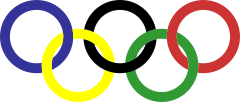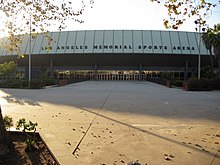Letnie Igrzyska Olimpijskie 1984
 | |
| Stolica igrzysk | |
|---|---|
| Liczba ekip | 140 |
| Liczba sportowców | 6797 |
| Liczba konkurencji | 221 w 23 dyscyplinach |
| Otwarcie | |
| Oficjalne otwarcie | prezydent USA Ronald Reagan |
| Zamknięcie | |
| Przysięga olimpijska | Edwin Moses (sportowcy) |
| Znicz olimpijski | |
| Stadion | |
Letnie Igrzyska Olimpijskie 1984, oficjalnie Igrzyska XXIII Olimpiady – wielosportowe zawody organizowane w Los Angeles w Stanach Zjednoczonych od 28 lipca do 12 sierpnia 1984 roku. Były to drugie w historii igrzyska zorganizowane w największym mieście Kalifornii oraz trzecie na terenie Stanów Zjednoczonych (szóste biorąc pod uwagę również edycje zimowe).
W rywalizacji sportowej udział wzięło 6 797 sportowców ze 140 państw. Zawody zostały zbojkotowane przez Związek Radziecki i w ślad za nim przez większość państw socjalistycznych. Oficjalnym powodem rezygnacji państw zza żelaznej kurtyny z udziału w rywalizacji sportowej była obawa przed smogiem oraz brak bezpieczeństwa i odpowiedniego zaplecza sportowego – faktycznie jednak były to retorsje za bojkot poprzednich igrzysk w Moskwie przez Stany Zjednoczone i część państw zachodnich. Państwa bojkotujące igrzyska w Los Angeles zorganizowały w tym samym roku zawody Przyjaźń-84, które jednak nie kolidowały terminowo z rywalizacją olimpijską (z wyjątkiem rywalizacji jeździeckiej).
Igrzyska XXIII Olimpiady zakończyły się zwycięstwem gospodarzy w klasyfikacji medalowej; sportowcy ze Stanów Zjednoczonych zdobyli łącznie 83 złote medale. Na drugim miejscu z 20 złotymi medalami uplasowała się reprezentacja Rumunii, która była jednym z nielicznych państw socjalistycznych, które nie wsparły bojkotu.
Względy polityczne
Ze względów politycznych, w ramach retorsji za nieobecność USA i innych państw zachodnich podczas Letnich Igrzysk Olimpijskich 1980 z udziału wycofała się reprezentacja ZSRR. W ślad za nią poszły Bułgaria, NRD, Wietnam, Mongolia, Czechosłowacja, Laos i Afganistan. Później podobną decyzję narzucono sportowcom innych krajów socjalistycznych: Polski, Kuby, Etiopii, Korei Północnej, Węgier. Kraje te zorganizowały własny cykl zawodów sportowych pod nazwą Przyjaźń-84. Jedynymi państwami socjalistycznymi, które nie zbojkotowały Igrzysk były Chiny, Ludowa Republika Konga, Jugosławia i Rumunia.
Państwa biorące udział w igrzyskach
Na igrzyskach w Los Angeles zadebiutowało 18 krajów: Bahrajn, Bangladesz, Bhutan, Brytyjskie Wyspy Dziewicze, Dżibuti, Gwinea Równikowa, Gambia, Grenada, Mauretania, Mauritius, Jemen Północny, Oman, Katar, Ruanda, Samoa, Wyspy Salomona, Tonga i Zjednoczone Emiraty Arabskie.
Państwa bojkotujące igrzyska
 Afganistan
Afganistan Angola
Angola Bułgaria
Bułgaria Czechosłowacja
Czechosłowacja Etiopia
Etiopia Iran
Iran Korea Północna
Korea Północna Kuba
Kuba Laos
Laos Mongolia
Mongolia Libia
Libia NRD
NRD Polska
Polska Węgry
Węgry Wietnam
Wietnam ZSRR
ZSRR
Organizacja Igrzysk
Były to już drugie Igrzyska Olimpijskie w Los Angeles. Po raz pierwszy organizacja takiej imprezy została powierzona prywatnej spółce. Na czele Komitetu Organizacyjnego Igrzysk stanął Peter Ueberroth, właściciel firmy turystycznej. Niektóre obiekty sportowe wybudowały firmy sponsorujące igrzyska, np. McDonald’s wybudował zespół basenów[1].
Głównym obiektem Igrzysk był stadion Los Angeles Memorial Coliseum, na którym odbywały się również zawody w 1932.
Otwarcie
W zawodach brało udział 140 państw. Wszystkich zawodników było 6802, w tym 1567 kobiet. Wszystkich dyscyplin było 21, w tym 221 konkurencji. Uroczystość otwarcia odbyła się 28 lipca 1984 na stadionie Los Angeles Memorial Coliseum. Uroczystego otwarcia dokonał prezydent Stanów Zjednoczonych Ronald Reagan, a znicz zapalił lekkoatleta Rafer Johnson.
Dyscypliny
 Boks (12) (szczegóły)
Boks (12) (szczegóły) Gimnastyka (14) (szczegóły)
Gimnastyka (14) (szczegóły) Hokej na trawie (2) (szczegóły)
Hokej na trawie (2) (szczegóły) Jeździectwo (6) (szczegóły)
Jeździectwo (6) (szczegóły) Judo (8) (szczegóły)
Judo (8) (szczegóły) Kajakarstwo (12) (szczegóły)
Kajakarstwo (12) (szczegóły) Kolarstwo (8) (szczegóły)
Kolarstwo (8) (szczegóły) Koszykówka (2) (szczegóły)
Koszykówka (2) (szczegóły) Lekkoatletyka (41) (szczegóły)
Lekkoatletyka (41) (szczegóły) Łucznictwo (2) (szczegóły)
Łucznictwo (2) (szczegóły) Pięciobój nowoczesny (2) (szczegóły)
Pięciobój nowoczesny (2) (szczegóły) Piłka nożna (1) (szczegóły)
Piłka nożna (1) (szczegóły) Piłka ręczna (2) (szczegóły)
Piłka ręczna (2) (szczegóły) Piłka wodna (1) (szczegóły)
Piłka wodna (1) (szczegóły) Pływanie (29) (szczegóły)
Pływanie (29) (szczegóły) Pływanie synchroniczne (2) (szczegóły)
Pływanie synchroniczne (2) (szczegóły) Podnoszenie ciężarów (10) (szczegóły)
Podnoszenie ciężarów (10) (szczegóły) Piłka siatkowa (2) (szczegóły)
Piłka siatkowa (2) (szczegóły) Skoki do wody (4) (szczegóły)
Skoki do wody (4) (szczegóły) Strzelectwo (11) (szczegóły)
Strzelectwo (11) (szczegóły) Szermierka (8) (szczegóły)
Szermierka (8) (szczegóły) Wioślarstwo (14) (szczegóły)
Wioślarstwo (14) (szczegóły) Zapasy (20) (szczegóły)
Zapasy (20) (szczegóły) Żeglarstwo (7) (szczegóły)
Żeglarstwo (7) (szczegóły)
W ramach Igrzysk XXIII Olimpiady rozegrano także dwie konkurencje pokazowe:
 Baseball (1) (szczegóły)
Baseball (1) (szczegóły) Tenis ziemny (2) (szczegóły)
Tenis ziemny (2) (szczegóły)
Obiekty sportowe

Obiekty sportowe na terenie miasta Los Angeles:
- Los Angeles Memorial Coliseum – ceremonia otwarcia i zamknięcia, lekkoatletyka
- Los Angeles Memorial Sports Arena – boks
- Dodger Stadium – baseball
- Edwin W. Pauley Pavilion – gimnastyka
- Eagle’s Nest Arena – judo
- Olympic Swim Stadium – pływanie, pływanie synchroniczne, skoki do wody
- Los Angeles Tennis Center – tenis
- Albert Gersten Pavilion – podnoszenie ciężarów
- ulice Los Angeles – lekkoatletyka
Obiekty sportowe w południowej Kalifornii (oprócz Los Angeles):
- El Dorado Park, Long Beach – łucznictwo
- The Forum, Inglewood – koszykówka
- Jezioro Casitas, Hrabstwo Ventura – kajakarstwo, wioślarstwo
- Olympic Velodrome, Carson – kolarstwo
- Santa Anita Park, Arcadia – jeździectwo
- Fairbanks Ranch Country Club, Rancho Santa Fe – jeździectwo
- Long Beach Convention Center, Long Beach – szermierka, siatkówka
- Rose Bowl, Pasadena – piłka nożna
- Titan Gymnasium, Fullerton – piłka ręczna
- Weingart Stadium, Monterey Park – hokej na trawie
- Coto de Caza, Hrabstwo Orange – pięciobój nowoczesny
- Prado Regional Park, Chino – strzelectwo
- Raleigh Runnels Memorial Pool, Malibu – piłka wodna
- Anaheim Convention Center, Anaheim – zapasy
- Long Beach Shoreline Marina, Long Beach – żeglarstwo
- Heritage Park Aquatic Center, Irvine – pięciobój nowoczesny
- ulice Mission Viejo – kolarstwo
- ulice Santa Monica – lekkoatletyka
Pozostałe obiekty:
- Harvard Stadium, Boston – piłka nożna
- Navy-Marine Corps Memorial Stadium, Annapolis – piłka nożna
- Stanford Stadium, Stanford – piłka nożna
Statystyka medalowa
W klasyfikacji medalowej igrzysk zwyciężyli zdecydowanie Amerykanie zdobywając 174 medale (83 złote, 61 srebrnych, 30 brązowych). Drugie miejsce zdobyli Rumuni z 53 medalami (20 złotych, 16 srebrnych, 17 brązowych). Trzecie miejsce zdobyli Niemcy z 59 medalami (17 złotych, 19 srebrnych, 23 brązowe). Najwięcej medali zdobyli Ecaterina Szabó z Rumunii i Amerykanin Carl Lewis.
| Klasyfikacja medalowa | |||||
| Lp. | Państwo | złoto | srebro | brąz | razem |
|---|---|---|---|---|---|
| 1 | 83 | 61 | 30 | 174 | |
| 2 | 20 | 16 | 17 | 53 | |
| 3 | 17 | 19 | 23 | 59 | |
| 4 | 15 | 8 | 9 | 32 | |
| 5 | 14 | 6 | 12 | 32 | |
| 6 | 10 | 18 | 16 | 44 | |
| 7 | 10 | 8 | 14 | 32 | |
| 8 | 8 | 1 | 2 | 11 | |
| 9 | 7 | 4 | 7 | 18 | |
| 10 | 6 | 6 | 7 | 19 | |
| Zobacz pełną klasyfikację medalową | |||||
Maskotka
Sam jest bielikiem amerykańskim wzorowanym na Wuju Samie, który pojawiał się często na różnych plakatach propagandowych. Zaprojektował go Robert Moore ze studia Walta Disneya.
Prawa do transmisji
Igrzyska były transmitowane przez następujące stacje telewizyjne:
 Australia: Network Ten
Australia: Network Ten Brazylia: Rede Globo, Rede Manchete, SBT, Rede Bandeirantes
Brazylia: Rede Globo, Rede Manchete, SBT, Rede Bandeirantes Brunei: RTB
Brunei: RTB Chiny: CCTV
Chiny: CCTV Filipiny: NBN
Filipiny: NBN Francja: TF1
Francja: TF1 Hiszpania: TVE
Hiszpania: TVE Holandia: NPO
Holandia: NPO Hongkong: ATV i TVB
Hongkong: ATV i TVB Indie: Doordarshan
Indie: Doordarshan Indonezja: Televisi Republik Indonesia
Indonezja: Televisi Republik Indonesia Irlandia: RTÉ
Irlandia: RTÉ Japonia: NHK
Japonia: NHK Kanada: CBC
Kanada: CBC Korea Południowa: KBS i MBC
Korea Południowa: KBS i MBC Makau: TDM
Makau: TDM Malezja: TV3
Malezja: TV3 Meksyk: Televisa
Meksyk: Televisa NRD: DFF
NRD: DFF RFN: ARD i ZDF
RFN: ARD i ZDF Nowa Zelandia: TVNZ
Nowa Zelandia: TVNZ Polska: TVP
Polska: TVP Singapur: MediaCorp
Singapur: MediaCorp Stany Zjednoczone: ABC
Stany Zjednoczone: ABC Szwecja: SVT
Szwecja: SVT Tajlandia: NBT
Tajlandia: NBT Tajwan: TTV, CTV i CTS
Tajwan: TTV, CTV i CTS Turcja: TRT
Turcja: TRT Węgry: MTV
Węgry: MTV Wielka Brytania: BBC
Wielka Brytania: BBC Włochy: RAI
Włochy: RAI ZSRR: Centralna Telewizja ZSRR
ZSRR: Centralna Telewizja ZSRR
Oficjalne gry Igrzysk
Atari zostało nazwane oficjalną grą wideo i komputerem letnich IO 1984. Dla uczestników oznaczało to dostęp do automatów, konsol i komputerów Atari w ich mieszkaniach. Dla pozostałych osób oznaczało to możliwość obejrzenia planowanych zawodów w międzynarodowych e-sportowych rozgrywkach z mistrzami z wielu krajów[2].
Wykorzystywano także komputery Atari800 do analizy wyników i różnych danych w reprezentacji siatkarek[3].
Doszło też do pewnego skandalu – Epyx wysłał grę „Summer Olympics” Sowietom, by mogli chociaż wirtualnie uczestniczyć w IO. Problemem nie było to, że zostali włączeni jako uczestnicy igrzysk – wiadomość o bojkocie dotarła do firmy prawdopodobnie za późno. Po tygodniu ich ambasada odpisała, że dziękują za dyskietki, ale jest jeden mały problem. Problemem było to, że byli oni użytkownikami Atari, a dostali wersję na C64. Epyx szybko wysłał wersję na Atari, ale nie dostał odpowiedzi czy gra się podobała. Możliwe też, że urażeni byli użyciem „Międzynarodówki” zamiast poprawnego hymnu ZSRR[4].
Przypisy
- ↑ Władysław Minkiewicz: Olimpijska gorączka. Poznań: SAWW, 1991, s. 158. ISBN 83-85066-26-8.
- ↑ Atari Age, 3 1982.
- ↑ Atari’s Olympic Team, atarimagazines.com [dostęp 2017-11-24].
- ↑ In 1984 Epyx Sent A Commodore 64 Copy Of Summer Games To The Soviets, Who Couldn’t Play It Because They Only Had Ataris [dostęp 2017-11-24].
Linki zewnętrzne
- Polski Komitet Olimpijski – Los Angeles 1984. pkol.pl. [zarchiwizowane z tego adresu (2012-08-15)].
Media użyte na tej stronie
Olympic Rings without "rims" (gaps between the rings), As used, eg. in the logos of the 2008 and 2016 Olympics. The colour scheme applied here pertains to the 2016 Olympics in Rio de Janeiro.
Olympic Rings without "rims" (gaps between the rings), As used, eg. in the logos of the 2008 and 2016 Olympics. The colour scheme applied here pertains to the 2016 Olympics in Rio de Janeiro.
Autor: https://phabricator.wikimedia.org/diffusion/GOJU/browse/master/AUTHORS.txt, Licencja: MIT
An icon from the OOjs UI MediaWiki lib.
Autor: https://phabricator.wikimedia.org/diffusion/GOJU/browse/master/AUTHORS.txt, Licencja: MIT
An icon from the OOjs UI MediaWiki lib.
The flag of Navassa Island is simply the United States flag. It does not have a "local" flag or "unofficial" flag; it is an uninhabited island. The version with a profile view was based on Flags of the World and as a fictional design has no status warranting a place on any Wiki. It was made up by a random person with no connection to the island, it has never flown on the island, and it has never received any sort of recognition or validation by any authority. The person quoted on that page has no authority to bestow a flag, "unofficial" or otherwise, on the island.
1910 Flag of Bermuda (with smaller coat of arms)
Flag of Brazil (1968-1992)
Łatwo można dodać ramkę naokoło tej grafiki
The flag of the Dominican Republic has a centered white cross that extends to the edges. This emblem is similar to the flag design and shows a bible, a cross of gold and 6 Dominican flags. There are branches of olive and palm around the shield and above on the ribbon is the motto "Dios,Patria!, Libertad" ("God, Country, Freedom") and to amiable freedom. The blue is said to stand for liberty, red for the fire and blood of the independence struggle and the white cross symbolized that God has not forgotten his people. "Republica Dominicana". The Dominican flag was designed by Juan Pablo Duarte, father of the national Independence of Dominican Republic. The first dominican flag was sewn by a young lady named Concepción Bona, who lived across the street of El Baluarte, monument where the patriots gathered to fight for the independence, the night of February 27th, 1844. Concepción Bona was helped by her first cousin María de Jesús Pina.
The Egyptian flag (1972-1984). Also the flag of Libya (1972-1977) and Syria (1972-1980), when the three countries formed the nominal “Federation of Arab Republics”. (For a map of the federation, see Image:Esl.PNG.)
The Arab text in the scroll held by the “Golden Hawk of Qureish” reads Arabic اتحاد الجمهوريات العربية, ittiħād al-jumhūriyyāt al-`arabiyya, i.e. the Federation (literally “Union”) of Arab Republics — in a quasi-Kufic script (in its original form, with a very ornamental letter dal د).
The Egyptian flag (1972-1984). Also the flag of Libya (1972-1977) and Syria (1972-1980), when the three countries formed the nominal “Federation of Arab Republics”. (For a map of the federation, see Image:Esl.PNG.)
The Arab text in the scroll held by the “Golden Hawk of Qureish” reads Arabic اتحاد الجمهوريات العربية, ittiħād al-jumhūriyyāt al-`arabiyya, i.e. the Federation (literally “Union”) of Arab Republics — in a quasi-Kufic script (in its original form, with a very ornamental letter dal د).
Made by author of Xramp, first uploaded by Denelson83 as Flag of Ecuador.svg, modifications by Husunqu.
Flaga Finlandii
Autor: Pedro A. Gracia Fajardo, escudo de Manual de Imagen Institucional de la Administración General del Estado, Licencja: CC0
Flaga Hiszpanii
The Flag of India. The colours are saffron, white and green. The navy blue wheel in the center of the flag has a diameter approximately the width of the white band and is called Ashoka's Dharma Chakra, with 24 spokes (after Ashoka, the Great). Each spoke depicts one hour of the day, portraying the prevalence of righteousness all 24 hours of it.
bendera Indonesia
Flag of Israel. Shows a Magen David (“Shield of David”) between two stripes. The Shield of David is a traditional Jewish symbol. The stripes symbolize a Jewish prayer shawl (tallit).
Flag of Jamaica. “The sunshine, the land is green, and the people are strong and bold” is the symbolism of the colours of the flag. GOLD represents the natural wealth and beauty of sunlight; GREEN represents hope and agricultural resources; BLACK represents the strength and creativity of the people. The original symbolism, however, was "Hardships there are, but the land is green, and the sun shineth", where BLACK represented the hardships being faced.
Variant version of a flag of Japan, used between January 27, 1870 and August 13, 1999 (aspect ratio 7:10).
Flag of the Socialist Federal Republic of Yugoslavia (1946-1992).
The design (blazon) is defined in Article 4 of the Constitution for the Republic of Yugoslavia (1946). [1]
Flag of the Socialist Federal Republic of Yugoslavia (1946-1992).
The design (blazon) is defined in Article 4 of the Constitution for the Republic of Yugoslavia (1946). [1]
Flag of Canada introduced in 1965, using Pantone colors. This design replaced the Canadian Red Ensign design.
Flag of the People's Republic of Congo between 1 January 1970 - 10 June 1991
Flag of South Korea (1949-1984)
(c) Zscout370 z angielskiej Wikipedii, CC-BY-SA-3.0
The first flag of the nation of Lesotho, used from 1966 until 1987. Elements from this flag can be seen on the current national flag, in use starting in 2006.
Flag of Liechtenstein
Please do not replace the simplified code by a version created with Inkscape or another vector graphics editor❗
Flag of New Zealand. Specification: http://www.mch.govt.nz/nzflag/description.html , quoting New Zealand Gazette, 27 June 1902.
Flag of Portugal, created by Columbano Bordalo Pinheiro (1857-1929), officially adopted by Portuguese government in June 30th 1911 (in use since about November 1910). Color shades matching the RGB values officially reccomended here. (PMS values should be used for direct ink or textile; CMYK for 4-color offset printing on paper; this is an image for screen display, RGB should be used.)
Flag of Romania, (21 August 1965 - 22 December 1989/officialy 27 December 1989).
Construction sheet of the Flag of Romania as depicted in Decree nr. 972 from 5 November 1968.
- l = 2/3 × L
- C = 1/3 × L
- S = 2/5 × l
Flag of Romania, (21 August 1965 - 22 December 1989/officialy 27 December 1989).
Construction sheet of the Flag of Romania as depicted in Decree nr. 972 from 5 November 1968.
- l = 2/3 × L
- C = 1/3 × L
- S = 2/5 × l
Flag of Senegal
Łatwo można dodać ramkę naokoło tej grafiki
The national flag of Kingdom of Thailand since September 2017; there are total of 3 colours:
- Red represents the blood spilt to protect Thailand’s independence and often more simply described as representing the nation.
- White represents the religion of Buddhism, the predominant religion of the nation
- Blue represents the monarchy of the nation, which is recognised as the centre of Thai hearts.
Official flag used by the Fédération Internationale de Football Association (FIFA) to represent Chinese Taipei in association football matches. Also used at the Olympics from 1986 to 2010.
Flag of Tunisia until 1999.
State Flag of Venezuela 1930-2006, New flag was introduced 13 March 2006.
Flag of Italy from 1946 to 2003, when exact colors were specified.
Flag of the Ivory Coast, written by Jon Harald Søby, modified by Zscout370. The colors match to what is reported at http://fotw.vexillum.com/flags/ci.html.
Flag of Zambia before 1996
Flag of the Democratic Republic of Afghanistan (1980-1987). Aspect ratio: 2:1.
Autor: Scroch, Licencja: CC BY-SA 3.0
Flag of Bulgaria (1971-1990). Flag of Bulgaria with Bulgarian coat from 1971.
Flag of Laos
Flaga Rzeczypospolitej Polskiej, a później Polskiej Rzeczypospolitej Ludowej w okresie 1928-1980 ustanowiona rozporządzeniem Prezydenta Rzeczypospolitej z dnia 13 grudnia 1927 r. o godłach i barwach państwowych oraz o oznakach, chorągwiach i pieczęciach, Dz. U. z 1927 r. Nr 115, poz. 980 i potwierdzona dekretem z dnia 9 listopada 1955 r. o znakach Sił Zbrojnych, Dz. U. z 1955 r. Nr 47, poz. 315.
Do odwzorowania barwy czerwonej użyto domyślnego odcienia "vermilion" (#E34234, cynober). Proporcje 5:8 (w dekrecie z 1955 roku błędnie ustalone jako 3:8, skorygowane w obwieszczeniu Prezesa Rady Ministrów z dnia 20 lutego 1956 r. o sprostowania błędu w dekrecie z dnia 7 grudnia 1955 r. o godle i barwach Polskiej Rzeczypospolitej Ludowej oraz o pieczęciach państwowych, Dz.U. z 1955 r. Nr 47 poz. 314).
Flaga Rzeczypospolitej Polskiej, a później Polskiej Rzeczypospolitej Ludowej w okresie 1928-1980 ustanowiona rozporządzeniem Prezydenta Rzeczypospolitej z dnia 13 grudnia 1927 r. o godłach i barwach państwowych oraz o oznakach, chorągwiach i pieczęciach, Dz. U. z 1927 r. Nr 115, poz. 980 i potwierdzona dekretem z dnia 9 listopada 1955 r. o znakach Sił Zbrojnych, Dz. U. z 1955 r. Nr 47, poz. 315.
Do odwzorowania barwy czerwonej użyto domyślnego odcienia "vermilion" (#E34234, cynober). Proporcje 5:8 (w dekrecie z 1955 roku błędnie ustalone jako 3:8, skorygowane w obwieszczeniu Prezesa Rady Ministrów z dnia 20 lutego 1956 r. o sprostowania błędu w dekrecie z dnia 7 grudnia 1955 r. o godle i barwach Polskiej Rzeczypospolitej Ludowej oraz o pieczęciach państwowych, Dz.U. z 1955 r. Nr 47 poz. 314).
Pictograms of Olympic sports - Boxing. This is unofficial sample picture. Images of official Olympic pictograms for 1948 Summer Olympics and all Summer Olympics since 1964 can be found in corresponding Official Reports.
Pictograms of Olympic sports - Gymnastics (artistic). This is unofficial sample picture. Images of official Olympic pictograms for 1948 Summer Olympics and all Summer Olympics since 1964 can be found in corresponding Official Reports.
Pictograms of Olympic sports - Field hockey. This is unofficial sample picture. Images of official Olympic pictograms for 1948 Summer Olympics and all Summer Olympics since 1964 can be found in corresponding Official Reports.
Pictograma de los juegos ecuestres.
Pictograms of Olympic sports - Judo. This is unofficial sample picture. Images of official Olympic pictograms for the 1948 Summer Olympics and all Summer Olympics since 1964 can be found in corresponding Official Reports.
Pictograms of Olympic sports - Canoeing (flatwater). This is unofficial sample picture. Images of official Olympic pictograms for 1948 Summer Olympics and all Summer Olympics since 1964 can be found in corresponding Official Reports.
Pictograms of Olympic sports - Cycling (road). This is unofficial sample picture. Images of official Olympic pictograms for 1948 Summer Olympics and all Summer Olympics since 1964 can be found in corresponding Official Reports.
Pictograms of Olympic sports - Basketball. This is unofficial sample picture. Images of official Olympic pictograms for 1948 Summer Olympics and all Summer Olympics since 1964 can be found in corresponding Official Reports.
Pictograms of Olympic sports – . This is an unofficial sample picture. Images of official Olympic pictograms for 1948 Summer Olympics and all Summer Olympics since 1964 can be found in corresponding Official Reports.
Pictograms of Olympic sports - Archery. This is unofficial sample picture. Images of official Olympic pictograms for 1948 Summer Olympics and all Summer Olympics since 1964 can be found in corresponding Official Reports.
Pictograms of Olympic sports - Modern pentathlon. This is unofficial sample picture. Images of official Olympic pictograms for 1948 Summer Olympics and all Summer Olympics since 1964 can be found in corresponding Official Reports.
Pictograms of Olympic sports - Football. This is unofficial sample picture. Images of official Olympic pictograms for 1948 Summer Olympics and all Summer Olympics since 1964 can be found in corresponding Official Reports.
Pictograms of Olympic sports - Handball. This is unofficial sample picture. Images of official Olympic pictograms for 1948 Summer Olympics and all Summer Olympics since 1964 can be found in corresponding Official Reports.
Pictograms of Olympic sports - Water polo. This is unofficial sample picture. Images of official Olympic pictograms for 1948 Summer Olympics and all Summer Olympics since 1964 can be found in corresponding Official Reports.
Pictograms of Olympic sports - Swimming. This is unofficial sample picture. Images of official Olympic pictograms for 1948 Summer Olympics and all Summer Olympics since 1964 can be found in corresponding Official Reports.
Pictograms of Olympic sports - Weightlifting. This is unofficial sample picture. Images of official Olympic pictograms for 1948 Summer Olympics and all Summer Olympics since 1964 can be found in corresponding Official Reports.
Pictograms of Olympic sports - Volleyball (indoor). This is unofficial sample picture. Images of official Olympic pictograms for 1948 Summer Olympics and all Summer Olympics since 1964 can be found in corresponding Official Reports.
Pictograms of Olympic sports - Volleyball (indoor). This is unofficial sample picture. Images of official Olympic pictograms for 1948 Summer Olympics and all Summer Olympics since 1964 can be found in corresponding Official Reports.
Pictograms of Olympic sports - Diving. This is unofficial sample picture. Images of official Olympic pictograms for 1948 Summer Olympics and all Summer Olympics since 1964 can be found in corresponding Official Reports.
Pictograms of Olympic sports - Shooting. This is unofficial sample picture. Images of official Olympic pictograms for 1948 Summer Olympics and all Summer Olympics since 1964 can be found in corresponding Official Reports.
Pictograms of Olympic sports - Fencing. This is unofficial sample picture. Images of official Olympic pictograms for 1948 Summer Olympics and all Summer Olympics since 1964 can be found in corresponding Official Reports.
Pictograms of Olympic sports - Rowing. This is unofficial sample picture. Images of official Olympic pictograms for 1948 Summer Olympics and all Summer Olympics since 1964 can be found in corresponding Official Reports.
Pictograms of Olympic sports - Wrestling. This is unofficial sample picture. Images of official Olympic pictograms for 1948 Summer Olympics and all Summer Olympics since 1964 can be found in corresponding Official Reports.
Pictograms of Olympic sports - Sailing. This is unofficial sample picture. Images of official Olympic pictograms for 1948 Summer Olympics and all Summer Olympics since 1964 can be found in corresponding Official Reports.
Pictograms of Olympic sports - Baseball. This is unofficial sample picture. Images of official Olympic pictograms for 1948 Summer Olympics and all Summer Olympics since 1964 can be found in corresponding Official Reports.
Pictograms of Olympic sports - Tennis. This is unofficial sample picture. Images of official Olympic pictograms for 1948 Summer Olympics and all Summer Olympics since 1964 can be found in corresponding Official Reports.
Lake Casitas Reservoir in Ventura County, California, seen looking east from California highway 150.
Belize Flag before August 28, 2019 Standardzations SVG from 3 September 2019 revision by FDRMRZUSA
Pictograms of Olympic sports - Synchronized swimming. This is unofficial sample picture. Images of official Olympic pictograms for 1948 Summer Olympics and all Summer Olympics since 1964 can be found in corresponding Official Reports.
This is the flag of Bahrain used from 1972 until 2002. The base image is from the 2002 CIA World Factbook (mirrored at UMSL). I have removed the border and recolored the red section according to Image:Flag of Bahrain.svg.
The former flag of Rwanda (1962-2001). Commonly refered to as the "R" flag.
(c) Pelladon z angielskiej Wikipedii, CC BY 3.0
- Description: Los Angeles Memorial Sports Arena
- Source: Photograph on 15.11.2005
- Photographer: Pelladon
- Copyright: Copyright © 2005 Richard H. Kim
Pictograms of Olympic sports - Canoeing (flatwater). This is unofficial sample picture. Images of official Olympic pictograms for 1948 Summer Olympics and all Summer Olympics since 1964 can be found in corresponding Official Reports.
This is the flag of the Cayman Islands, prior to 1999 (It seems this version is still in use). The base pattern is from HK Blue Ensign and the arms are from the blue ensign. The FOTW was used for the position of the arms.
The three stars mean Grand Cayman(76miles), Cayman Brac(14miles), and Little Cayman(10miles).Autor: Tom Brandt, Licencja: CC BY 2.0
Photo of the Rose Bowl that has been taken right before the Rose Bowl of 1976 when Ohio was beat by UCLA
Flag of Iraq, 1963-1991. Also flag of Syria, 1963-1972.
The proportions of this flag are 3:2; however, there is no official definition for the correct proportions and also 5:3 is widely used.
The flag of San Marino, before the 2011 standardization
Flag of Oman from 1970 to 1995









































































































































































































